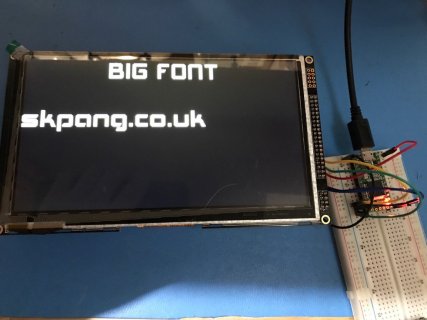@xerox - There have been a few displays and the like suggested here, however it is very hard for any of us to give you any complete suggestions, with as little information as you have so far provided, such as your current setup, an idea of your requirements and the like.
So far all we know is you have an ILI9341 display which has an XPT2046 touch screen controller. So my assumption is that you are using one by PJRC. What graphic library are you using to run it? There are at least a few like one by Adafruit, Paul's - ili9341_t3, Mine - ili9341_t3n, Frank's - ili9341_dma (I think)... Note: most of the libraries I mentioned here are or were based off of Adafruits, but there are areas we diverged and or extended. What processor are you using?
The reason I ask questions like this, is for example if your display code is based on one of these drivers, then there is a reasonable chance that if for example Adafruit sells a larger display that meets your requirements, than adapting the code to the new display may not be that difficult. It is not necessarily you have to purchase their display to use it, but obviously their code is more likely to have been tested on their displays...
Speed? - If your requirements are that you must have blazing fast updates to the screen, then you need to understand what using each type of display might do to your updates and the like.
Example: The ILI9341 has 320x240 pixels and it takes 2 bytes per pixel to update the screen(153600 bytes). The ILI9488 display is 480x320 (so twice as many pixels) AND it requires 3 bytes per pixel to be output (460800) so it takes 3 times as many bytes to be output over SPI to update the full display. So it takes 3 times as long...
RA8875 - Many of graphic primitives on these displays have hardware acceleration, so depending on your application, it may be slow it may not be. More details about this up on Sumotoys Wiki on this:
https://github.com/sumotoy/RA8875/wiki There are a few different libraries for these displays, including Adafruit (GFX) as well as Sumotoys...
Warning on using Sumotoy's libraries - There is a lot of great stuff there, but he has not been at all active for at least a couple of years, so many of these displays require changes to work with newer boards like the T4 and T3.6 or T3.5. Some of them have been adapted to work, and some of us have those on our machines, we are still trying to figure out a good way to handle this type of issue where the library owner is no longer active. Example we have a good version of the RA8875 library.
Again hard to give any other suggestions, without having some idea of what it is you actually need....


